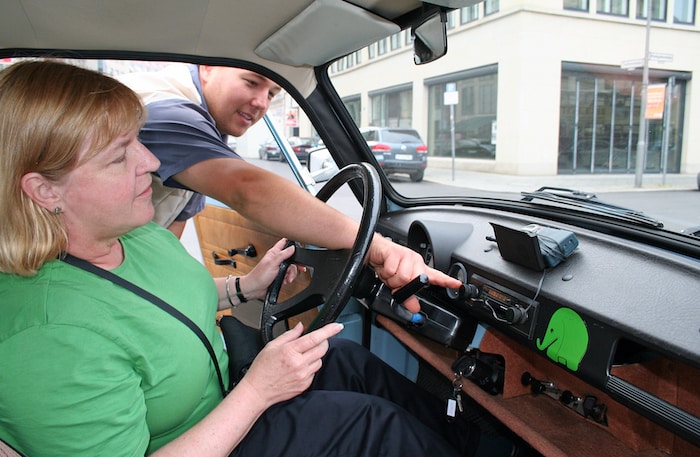
Writer Susan McKee prepares to drive the streets of Berlin in a vintage Trabant, the Soviet government’s answer to the Volkswagen Beetle.
A wave of terror washed over me as I squinted through the windshield and drove a Trabant in Berlin, Germany. There were other cars on the street around me, and hordes of pedestrians crowded the sidewalks. This was no time to be faint-hearted! My damp hands clutched the steering wheel with a death grip as I let out the clutch and stepped warily on the gas.
This is the car that was junked by the thousands after German reunification. Now they’ve become a tourist attraction.
My right foot continued to press on the gas pedal while my left hovered over the clutch. It was time to shift to second gear. I looked frantically at the dashboard.
The gearshift wasn’t on the floor, or even on the steering wheel, but sticking out of the dashboard. The L-shaped handle had no helpful labels anywhere to let me know what gear I was in.
What were those instructions? Oh, yes. Up was first, down was second – but up was also third and down was also fourth. Reverse? That was all the way out. Reverse was the last thing on my mind as I slammed the clutch to the floor and wrestled with the gearshift.
The original owners of “my” Trabi had painted a turquoise stripe on the gray metal of the gearshift where it emerged from the dash. Faded, but still visible, it was all I had to go by. A partial stripe visible meant first or second gear, the full half-inch of color meant third or fourth.
My pulse raced as the engine gained speed. In went the clutch, down went the gear lever – and the engine lugged. Oh, no! The engine told me I’d gone from first to fourth, so I slammed the clutch to the floor and tried for second again. The engine revolutions settled into a comfortable hum. My heart rate returned (almost) to normal.
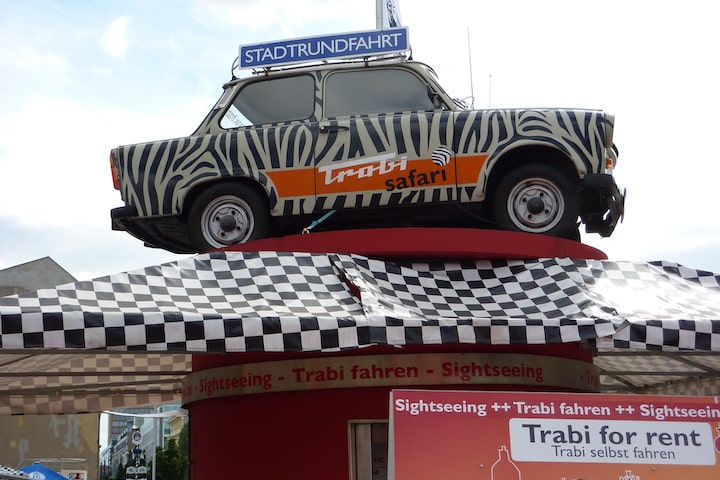
Clearly superior to the Yugo? History will decide.
As I gained speed, I slammed in the clutch again, and rearranged the gearshift into what I thought might be third, and timidly pressed the gas pedal. Whew! I kept moving forward without stalling.
Hurray! I’d made it a half-block on my driving adventure through the “Wild East” with Trabi Safari.
Fortunately, I was not alone on the streets of Berlin. When I was the driver, we traveled in a sort of Trabi sandwich. I concentrated on following the taillights of the lead car while the third car in the convoy protected my back. Instructions (“turn here”) were barked over the car’s loudspeakers as we bounced and squeaked along the streets. These days, there’s just a lead car, but it’s in radio contact with its followers at all times, and you’re usually in a convoy of several Trabis on a tour.
Shock absorbers and soundproofing? Not in a Trabi! I felt every bump in the road – and heard every cheer from passers-by, happy to see the Trabant resurrected and moving.
We started at the Gendarmenmarkt, a landmark square in the Mitte district of Berlin. I commanded the wheel for about 45 minutes of cruising through the streets of East Berlin. A second brave driver took over at the halfway point when we stopped at the East Side Gallery – the longest surviving stretch of the old Berlin Wall. Its original graffiti art (including the infamous Brezhnev kiss) is peeling now, as the memory of the bad old days of Communist rule fades.
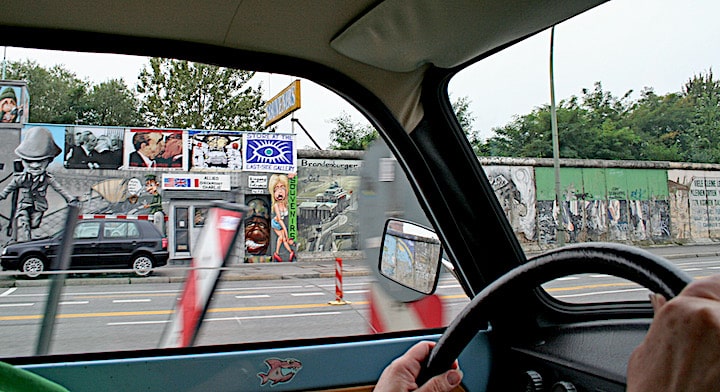
The East Side Gallery is a series of murals painted by 118 artists directly on a 1.3 mile-long remnant of the Berlin Wall It is located near the center of Berlin on Mühlenstraße in Friedrichshain-Kreuzberg. The gallery has official status as a Denkmal, or heritage-protected landmark.
Once I was a passenger instead of the driver, I could enjoy the ride. People waved at us as we drove along through Berlin, noticing the Trabants. We finished up alongside the remnant of Checkpoint Charlie, once the best-known Berlin Wall crossing point between East and West during the Cold War.
There are more than a hundred Trabis in the company garage, so you have your choice of style and color (mine was pale blue). There’s even the Stretchtrabi, a combination convertible and limousine if your group would prefer a chauffeur.
Manufactured between 1958 and 1991, Trabants are an unlikely symbol of Communist rule. They were the only car ordinary East Germans could buy during the days of the German Democratic Republic, so they represented a bit of freedom in an autocratic state.
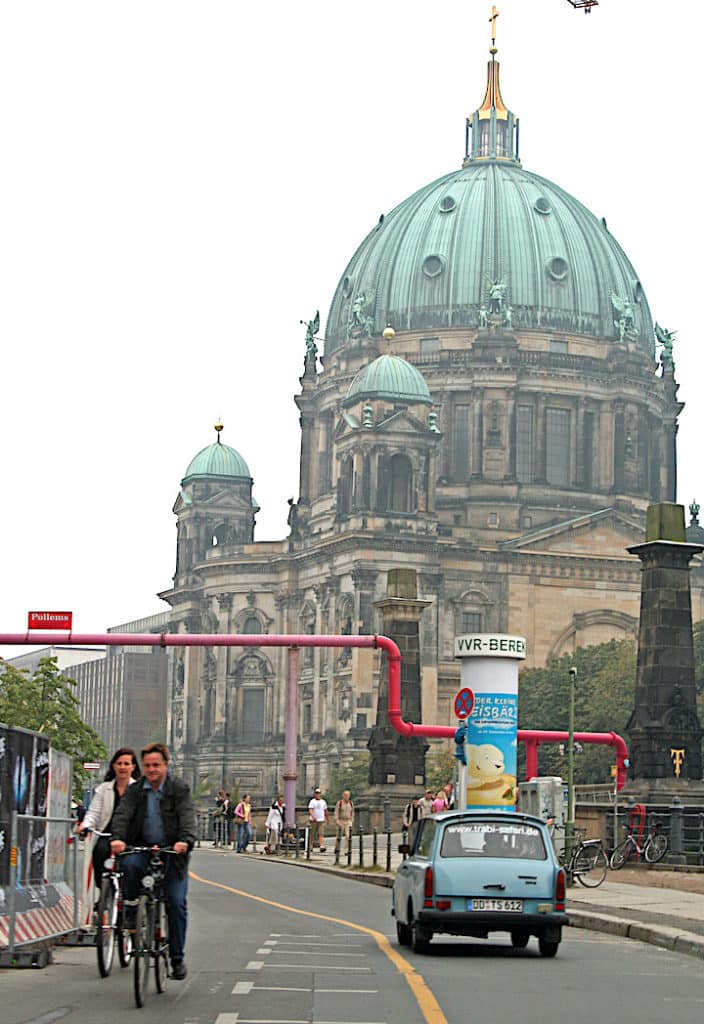
Trabi safaris roam the streets of the former East Berlin passing landmarks like the Protestant Cathedral, a center of worship in the Mitte District for several Protestant denominations. Damaged during World War II the building was left to languish under the GDR. Reopened in 1993, the Cathedral contains the tombs of Hohenzollern monarchs.
Trabis weren’t cheap– 30,000 pre-unification East German Deutsch Marks – and people waited for delivery an average of 12 years after ordering. Materials shortages behind the Iron Curtain resulted in a car made of Duroplast – a combination of cotton and phenolharz, a kind of plastic.
With a two-stroke, two-cylinder engine and 26 horsepower, Trabis are fueled like lawnmowers: one liter of oil for every 50 liters of gasoline. There’s no gas gauge, only a dipstick to check the level of petrol.
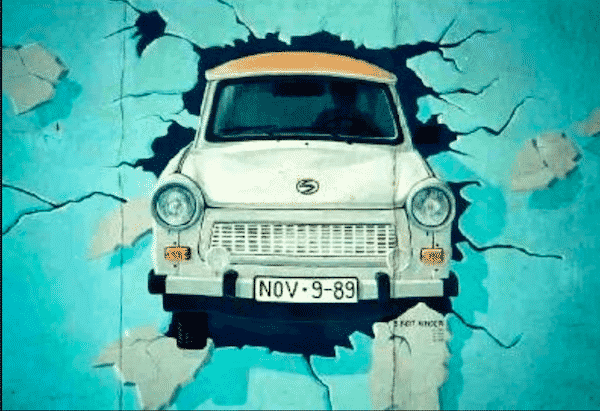
This old mural depicts a Trabant crashing through the Berlin Wall. That never happened. Neither did they successfully negotiate the West German autobahn. But showcased in the amber glow of history they remain a beloved symbol of a simpler time.
There’s no road rage in a Trabi, just gratitude when you make it back safely. Exhilarated after my drive, I stopped into a souvenir shop near Checkpoint Charlie. An American tourist was debating with his wife whether to buy a miniature yellow or a blue model of a Trabant. I pointed out the window at “my” blue Trabi and asked him, “Why settle for a toy when you can drive the real thing?”![]()
Writer and photographer Susan McKee travels the world from her base in Indianapolis, Indiana

